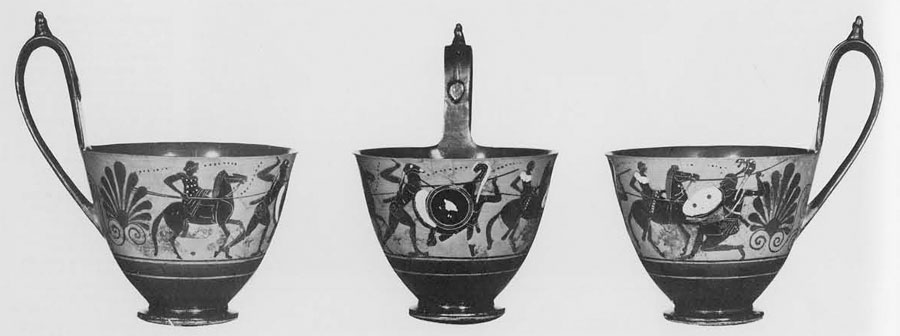
I have been working on a study of the Attic kyathos, examining most of the extant examples of this small black-figured vase made in the late sixth and very early fifth century B.C. The kyathos has a single high-slung handle, a cup about the size of a good coffee mug and a base which allows it to stand solidly upright. Almost all of the Attic kyathoi were made in the Nikosthenic workshop and exported to Italy where they were purchased by the Etruscans. Presumably, this type of vessel was used to ladle wine out of a large vat (krater) into any of the several ancient varieties of drinking cups.
A few years ago, the well preserved kyathos pictured here was offered for sale in Europe. It can be attributed to the Philon Painter whose total known work consists of seven other kyathoi with similar scenes. His work can only be called competent at best, but I hasten to add that he is far from the worst of the black-figure artists. Generally his work, including this vase, can be dated about 510-500 B.C. What is interesting about this particular vase is that it is possible to determine the way in which the artist went about painting the decoration.
The Philon Painter started with a fairly standard scene that he had used before on other vases. It is most likely that the artist did not just make up the scene but rather consulted a pattern book. Having looked at the pattern, we must not imagine that he kept it in front of him while he painted. There is too much individual variation from vase to vase with the same scene to postulate direct copying. Rather it was the general impression of the scene that he used.
For this scene there were to be two heavily armed warriors (called hoplites) fighting it out with spears and round shields in the center of the vase opposite the handle. On either side of this central combat there would have been a horseman attacking a kneeling warrior with a spear, and behind this grouping, on either side, a large palmette. But our vase has only one kneeling warrior (on the right). Furthermore, we can note four other details as an aid to our study. First, the left palmette is well painted, spreading evenly on both sides. Second, the kneeling warrior on the extreme right is larger in scale than the other figures. Third, this warrior’s right arm overlaps the large palmette. Finally, note that the left horseman is the most carefully executed figure on the vase.
What happened now becomes clear. The painter began with the large palmette on the left. He had plenty of room and used it: the palmette spreads out nicely in all directions. Then he turned to the other side of the handle and painted the palmette on the right-hand side but not quite as carefully: thus this one is a bit stubbier and less graceful. He proceeded on to paint the head and torso of the kneeling warrior on the right. He then realized that its right arm would have to overlap the palmette. (The nature of the black glaze shows that the arm was painted over the palmette.) When this figure was finished it became clear to our artist that if he continued using his present scale he would never have room enough to finish the pattern. Since horsemen were regularly painted on a smaller scale than standing or kneeling figures, it was a fairly simple operation to adjust the scale for the remaining figures.
He then painted the horseman, apparently working around the kneeling warrior’s shield. (Because of the added white paint on the shield, one cannot say exactly what came first in this area.) On he went, to the two standing hoplites fighting each other, again painting the right one first, as can be determined by the overlapping shields and the positions of the spears. But as he finished the left-hand warrior, the painter found himself trapped. Between the left-hand hoplite and the palmette, there was no room to paint both the horseman and the kneeling hoplite which he would need to balance his composition.
There were two alternatives he could follow. He might have again reduced his scale to fit in the two additional figures. But this would not have looked very well and, besides, at this point one wonders whether he had the skill to paint on the required small scale. The other choice was to omit one figure, which is what he did: out went the kneeling warrior. Still the painter was not out of his difficulties. He had to work rather cautiously to fit in the remaining horse and rider. Even so, the legs of the horse overlapped the right leg of the standing warrior. But it worked. If we listen for echoes, we might just hear Nikosthenes muttering as he walked by the Philon Painter, “proboulou” … plan ahead!
